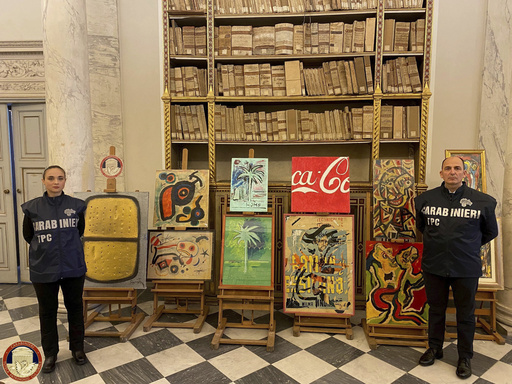
ROME — Italian officials have announced that they have successfully dismantled a sophisticated network of art forgers operating across Europe. This group was responsible for creating counterfeit artworks that mimicked the styles of renowned artists such as Andy Warhol, Banksy, and Pablo Picasso, which were then sold to unsuspecting customers, often with assistance from complicit auction houses.
Authorities have reported that 38 individuals are currently under investigation in relation to this scheme, with six of those suspects located in Spain, France, and Belgium. The impact of this fraudulent operation could potentially reach an astounding 200 million euros (approximately $212 million) due to the influx of counterfeit artworks into the market.
The Italian Ministry of Culture made an announcement on Monday detailing an extensive seizure that took place across Italy, France, Spain, and Belgium. Authorities confiscated around 2,100 counterfeit pieces attributed to more than 30 famous artists, including notable names such as Amedeo Modigliani, Joan Mirò, Francis Bacon, Wassily Kandinsky, Henry Moore, and Gustav Klimt, alongside the previously mentioned Warhol and Banksy.
The investigation revealed that the forgery ring operated mainly from Spain, France, and Belgium, where they produced these counterfeit artworks. According to Eurojust, the EU agency overseeing judicial cooperation, the forgeries predominantly featured imitations of Warhol and Banksy. These fakes were not only created but were also displayed at exhibitions held in Mestre and Cortona, Italy, with a formal catalogue produced for sale, authorities confirmed.
Moreover, Eurojust explained that the network had connections to auction houses in Italy that facilitated the sale of these forgeries by providing fake certificates and authenticity stamps. Authorities reported seizing approximately 500 of these fraudulent documents during the operation.
The investigation kicked off in March 2023 when Italian law enforcement discovered 200 counterfeit artworks in the residence of a businessman from Pisa. This initial find led to an extensive monitoring of e-commerce platforms and auction sites to uncover the larger network involved in these dealings. Those arrested in connection with the scheme face charges related to conspiracy for the production and sale of counterfeit contemporary art, according to Eurojust.
